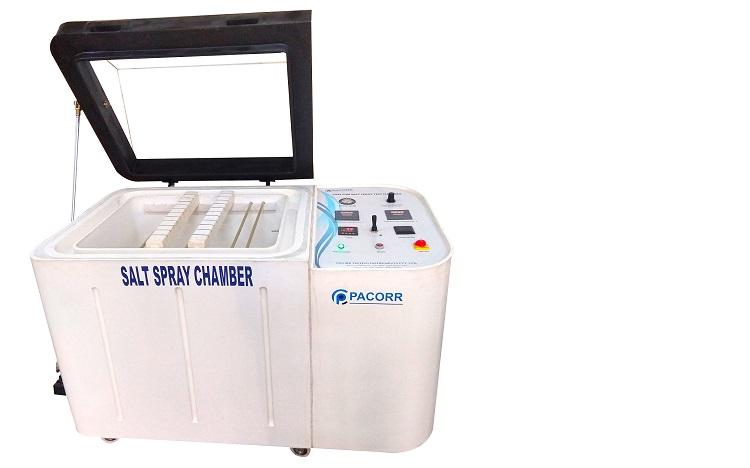The operation of a Salt Spray Chamber involves creating a highly corrosive environment by spraying a solution of salt and water onto test specimens, typically made of metal, plastic, or other materials. This process, known as the Salt Spray or Corrosion Test, uses a 5% sodium chloride (NaCl) solution, mimicking the salt content of seawater, under controlled temperature, humidity, and pH levels.
The duration of the test can vary, allowing for the evaluation of the specimen's corrosion resistance over time. After testing, specimens are inspected for corrosion signs, which help in assessing the material's or coating's durability.
The application of Salt Spray Chambers spans multiple industries, including automotive, aerospace, coatings, electronics, marine, and military, to test components such as automotive parts, aircraft structures, coatings, electronic components, and materials used in marine structures. This testing helps ensure that these materials can withstand harsh conditions and corrosive substances, thereby ensuring reliability and extending the lifetime of products.
What is a Salt Spray Chamber?
A Salt Spray Chamber is an essential tool used in the industrial testing of materials and coatings for corrosion resistance. By simulating a highly corrosive environment, typically through the dispersion of a salt-laden mist, it allows researchers and manufacturers to predict how materials will perform under harsh conditions.
How Does a Salt Spray Chamber Work?
The chamber works by atomizing a salt solution, usually sodium chloride, into a fine mist within a sealed testing compartment. The concentration of salt in the solution, the temperature, and the humidity within the chamber can be precisely controlled to replicate various corrosive environments. Test specimens are exposed to these conditions for predetermined periods to assess corrosion resistance.
What are the Benefits of Using a Salt Spray Chamber?
Predictive Analysis: Provides valuable data on how materials and coatings will withstand corrosive environments.
Quality Control: Ensures products meet required corrosion resistance standards.
Material Selection: Helps in choosing the right materials and coatings for specific applications.
Research and Development: Aids in the development of new, more corrosion-resistant materials and coatings.
What Types of Tests Can Be Performed in a Salt Spray Chamber?
Neutral Salt Spray (NSS) Test: The most common and involves a neutral (pH 6.5-7.2) salt solution.
Acetic Acid Salt Spray (AASS) Test: Introduces acetic acid into the salt solution, simulating more aggressive conditions.
Copper-Accelerated Acetic Acid Salt Spray (CASS) Test: Further accelerates corrosion through the addition of copper chloride, used for testing decorative chrome plating.
How Long Do Tests Typically Last?
Test duration can vary significantly depending on the standards being followed and the materials being tested. Some tests last a few hours, while others can extend for more than a thousand hours.
How Do I Maintain My Salt Spray Chamber?
Regular maintenance includes:
Cleaning the chamber and nozzles to prevent clogging.
Checking and calibrating the temperature and humidity controls.
Ensuring the salt solution concentration remains consistent.
Regularly inspecting for any signs of wear and tear.
What Are Common Issues with Salt Spray Chambers?
Nozzle Blockage: Salt build-up can block the nozzles, disrupting the mist.
Humidity and Temperature Fluctuations: Faulty sensors or heating elements can affect test conditions.
Corrosion of the Chamber Itself: Proper materials and maintenance are required to prevent the chamber from corroding.
Can Salt Spray Chambers Simulate All Types of Corrosive Environments?
While highly effective for many applications, Salt Spray Chambers cannot replicate every corrosive environment, such as those with UV exposure or mechanical wear. They are best used as part of a comprehensive testing program.
Where Can I Find Standards for Salt Spray Testing?
Standards are provided by organizations such as ASTM International, ISO, and specific industry bodies. These documents outline the specific conditions and procedures for various types of salt spray tests.
Conclusion
Salt Spray Chamber play a crucial role in ensuring the durability and reliability of materials and coatings in corrosive environments. By understanding their operation, benefits, and maintenance requirements, you can significantly enhance your product's quality and longevity. Whether you're in the early stages of research and development or ensuring your final product meets quality standards, a Corrosion Test Chamber is an invaluable tool in your arsenal.
Read More
https://www.pacorr.com/product/salt-spray-tester-manufacturers-suppliers/
Facebook: https://www.facebook.com/pacorrtestinginstruments
Twitter: https://twitter.com/Pacorr_testing
Instagram: https://www.instagram.com/pacorrtesting
Linkedin: https://www.linkedin.com/in/pacorr





